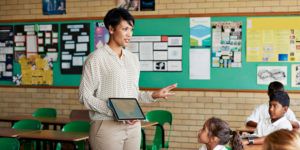Lockdown extension in the Philippines: How is education being affected?
In this article, we explore the current situation of the Philippines in lockdown, how communities have been affected and what you can do to maintain your child's education.

The effects of COVID-19 have been felt all over the world since the beginning of 2020, but as vaccines are administered globally, we’re starting to see the light at the end of the tunnel. In March, the Philippines began their rollout of the vaccine across the country, one year after strict lockdown measures were implemented.
Now, over 1.7 million Filipino people have received their first dose of the vaccine, which is a great sign of hope after the difficult year the country has had. However, numbers of infections are currently on the rise, and a new lockdown has been put in place.
In this article, we’ll explore the current situation in the Philippines with COVID-19, some success stories and negative repercussions of lockdown, and how education has been affected. We’ll finish off by providing guidance on how to support your children or students with remote schooling.
What is the current situation with the Philippines lockdown?
From March to May last year, parts of the Philippines endured an extremely strict lockdown called ECQ (Enhanced Community Quarantine), where people had to remain home, not use transport, have regulated food provisions and get used to a stronger police presence. In May, this was eased, but regulations still remained in place.
Since then, the country has been in a state of flux regarding lockdown restrictions, with the rules changing depending on the current number of cases. The latest lockdown began on April 5th this year and, was only intended to last a week in an attempt to slow down the spread of infection and provide overcrowded hospitals with some relief.
This may have been the right action to take, as the country has just surpassed 1 million total infections, but now officials must decide whether to extend the lockdown measures further and potentially suffer more economic and social repercussions.
How is lockdown affecting the Philippines?
As the Philippines continues to face lockdown regulations and restrictions, we take a look at how they’ve been coping. It’s been a tough time for everyone, and there have certainly been negative repercussions for the country, but surprisingly there have also been positive stories of communities coming together.
Negative impacts of COVID-19 and lockdown
Undoubtedly, there has been a negative economic impact on the country as a result of COVID-19 and extended lockdown. In 2020, the Philippines had a terrible recession, and gross domestic product reduced by 9.5%. For this reason, economic managers are not in favour of extending lockdown.
Additionally, the strain of continued social isolation, lack of schooling and reduced provisions has definitely taken its toll on Filipino people, as it has all across the world. If you’ve been struggling with this yourself, you can try our Social Care During COVID-19: Coping with Self-Isolation and Social Distancing course to learn some coping strategies.
There have recently been problems with hospitals becoming overcrowded due to the surge of new infections, and the Philippine Red Cross said they “urgently need more medical volunteers”. If you’re in the Philippines and want to volunteer, you may benefit from our COVID-19 Critical Care: Understanding and Application course, where you can learn how to provide care for critically ill patients of COVID-19.
Success stories from lockdown in the Philippines
Fortunately, there are some stories of Filipino people who have experienced positive consequences during the pandemic and lockdown alongside the negative ones. People have experienced a coming together of communities, or have got to spend more time with loved ones rather than spending all their time at work.
Communities coming together
Raul Dancel, a Filipino journalist, writes in an article, “Our vulnerabilities are suddenly exposed. That, in turn, is making us more empathetic. We realise we need one another. So we offer to help, in any way we can.”
He goes on to give examples of a cashier who now walks 6km a day to get to work, just so she can help her workplace out; a woman who has been helping her sick neighbours; and a man who has been giving his employees a weekly allowance out of his own pocket while they’re on furlough.
In an article for the Philippine News Agency (PNA), we can hear about Filipino residents who have been afforded more time to rest, take care of themselves and spend time with their families, showing there are silver linings to lockdown for some people.
Furthermore, generous Filipinos have created community pantries on sidewalks across the country, where they can donate food to the poor who may have been most affected by the pandemic. Although this is a reflection of the difficult circumstances people have faced, it also shows that people have been supporting each other and looking after their communities.
Reduced air pollution in Manila
On a different note entirely, one positive thing to come out of lockdown for the Philippines is the reduced air pollution in Manila, the capital. Air pollution has always been a problem in Manila and is responsible for 4,000 deaths a year. However, for the first time in decades, Filipinos were able to see the Sierra Madre mountains in April 2020.
The Department of Environment and Natural Resources (DENR) found there was a significant reduction in air pollution on January 1st, 2021 compared to the previous year, and this drop was as high as 59%. Air pollution can be really dangerous for inhabitants, and can even exacerbate symptoms of COVID-19, so this reduction is great news.
How is education in the Philippines holding up?
Seeing as lockdown measures have been so strict in the Philippines, children have not been able to go to school. They were closed in March of last year, but then in June 2020, officials stated that kids would only return to school when a vaccine was available.
There has now been a school shutdown lasting over a year, which certainly has brought a new set of challenges to many children, parents and teachers. While the education secretary announced that distance learning methods must be implemented, many Filipinos don’t have access to computers or good internet, making this difficult.
How can educators and parents implement distance learning?
As lockdown restrictions are here to stay for the time being, it’s crucial that educators and parents are able to provide some form of education for their children and students. Below, we’ll discuss the possibilities of online learning and offline education.
Helping children to study online
If you do have access to the internet and a device such as a phone, tablet or computer, the opportunities for distance learning are endless. We have a fantastic range of online courses over a number of subjects including maths, science, literature, design, computing and more.
Our courses can be accessed whenever and wherever you want, meaning that you can have a level of flexibility to schooling that doesn’t normally exist in a classroom. Lockdown has been hard on children, as they haven’t been able to go outdoors and socialise as much as they should, so taking a flexible approach to learning and seeing when suits them can be a good approach.
However, we know that it can be a big challenge to adapt to online learning and teaching when you’ve been used to being in a physical classroom. To help, we have plenty of online courses that will help you succeed, and we’ve listed some of these below:
Online teaching
- How To Teach Online: Providing Continuity for Students
- Online Teaching: Accessibility and Inclusive Learning
- Teaching Young Learners Online
- Resilient Teaching Through Times of Crisis and Change
Online learning
- Learning Online: Studying and Reflecting
- A Digital Edge: Essentials for the Online Learner
- How to Learn Online: Getting Started
- Learning Online: Communicating and Collaborating
Alternatives to online learning
Intermittent internet connectivity is an issue throughout the country, and of course, online learning is made even more difficult for poorer families who may not have access to a device with a screen.
The education secretary did announce that they would provide modular learning to students, which would be printed out and given to them, but there might be some other things you can try too. The activities below can be done with your child if you have time, but if not, you can encourage them to try and do them independently:
- Ask educators to make a list of free computers where you live
- Read different books with your child
- Get your child to build or create something
- Exercise or play sport with your child
- Give them a creative writing assignment
Final thoughts
Although the Philippines is still experiencing lockdown restrictions, it’s encouraging to see that people have been supporting each other and making the best of a bad situation. Now that vaccines are being provided, we hope to see the rate of infection slow down so that children can finally get back to school, and life can resume for many people.
In the meantime, we hope that these tips for distance learning can be of some help for parents and teachers. Our main focus at FutureLearn may be online learning, but accessible education in all formats is extremely important, as all children deserve an education.












